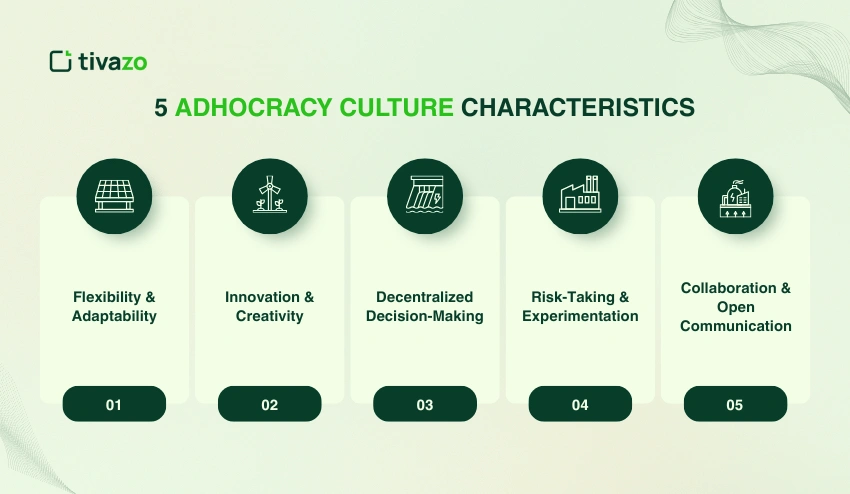Consider a working environment with free-flowing ideas, teams taking gamble moves, and failure is regarded as a progressive move towards innovation.
Such a culture is not a dream condition, as it is the reality of an ad hoc business environment today. This flexible work culture, which includes risk-taking, empowerment of employees, and free-flowing communication, is unlike strict hierarchies. Projects are created and disbanded in short durations, which allows agile organizations to fit and evolve quickly than the competition.
With the promotion of independence in the workplace, innovative problem-solving, and life-long learning, adhocracy culture forms the background to a strategy-oriented future and long-term development. The companies as Google, Spotify, and Tesla, demonstrate that such a way contributes to the adaptability of the market and generates groundbreaking ideas. Knowing the reason behind the importance of adhocracy culture is a blueprint that will help any leader and team succeed in the world of uncertainty, and also create a successful organization that is genuinely innovative.
👉You May Also Like: What Are the Different Types of Workplace Culture?
What is Adhocracy Culture?
Adhocracy culture is an organizational culture built on innovation, flexibility, and adaptability rather than rigid hierarchy. It encourages decentralized decision-making, giving employees autonomy at work and the freedom to experiment with new ideas.
How Adhocracy Culture Works
The adhocracy culture is achieved by breaking the traditional hierarchical culture and then developing a dynamic working culture. There is decentralization of decision-making, and this implies that employees at all levels are able to give their expertise and ideas. The strategy promotes independence in the workplace, innovative problem solving, and free communication, and this enables the teams to react swiftly to the market shifts and customer demands.
An adhocracy culture has teams that are project-based, which form and dissolve with changes in priorities. This organization encourages teamwork, creativity, and taking risks, and allows employees to explore and make mistakes. Through their focus on lifelong learning and empowerment of the employees, organizations can navigate the obstacles without feeling the lack of momentum or direction.
The outcome is an organization that is extremely agile and is able to remain at the top of the competitive industries. Companies such as Google, Tesla, and Spotify use strategy-driven approaches and adaptability in the market to promote growth and a culture of innovation. Simply put, the adhocracy culture can change workplaces into flexible, creative, and progressive spheres that are surviving in change.
Adhocracy Culture Characteristics
The adhocracy culture is based on flexibility, innovation, and empowerment of the employees. This dynamic work culture of decentralised decision-making, teamwork, and risk-taking, unlike traditional hierarchical workplaces allows organisations to change markets and customer needs faster.

1. Flexibility & Adaptability
Adhocracy culture is based on flexibility. Teams are advised to make any redesigns to workflows, explore new ways, and change strategies when necessary. It is a dynamic work culture that will assist in the future-based strategies and will allow the organization to react rapidly to changes in the industry.
Flexible organisations enable employees to come up with decisions immediately, thereby creating a sense of autonomy in the workplace and increasing the degree of employee empowerment. The ability to give teams the freedom to do what is right gives companies a chance to avoid bottlenecks and stay productive even when the environment is uncertain.
Creative problem-solving is also a result of flexibility. The innovativeness of the employees is not constrained by stricter rules, and this enhances the market flexibility and the organization stays competitive over the long term.
2. Innovation & Creativity
Adhocracy culture puts innovation and creativity on top of the hierarchical rules. The employees are advised to introduce radical ideas, experiment, and seek alternative ways of solving problems. This atmosphere of risk-taking encourages constant improvement and constant learning.
Open communication and joint projects strengthen creative problem-solving. The teams are free to share ideas, and the organization can take advantage of the different points of view and come up with breakthrough solutions.
Companies that are innovative, such as Google and Tesla, demonstrate how the adhocracy culture can drive agile organizations that can remain competitive in the industry. Employee engagement and satisfaction also increase through the encouragement of creativity.
3. Decentralized Decision-Making
Adhocracy culture has decentralized decision-making, with employees having power depending on their knowledge, as opposed to position. This gives teams the ability to work fast and make decisions, increasing the autonomy in the workplace and effectiveness.
Decentralization enhances cooperation since employees need to interact and liaise in functions to institute solutions. It lowers the bottlenecks, and the projects can continue to move without having to wait to be approved by the higher management.
Organizations empower employees by relying on the workforce to make essential decisions and develop an energetic working culture. The given approach also promotes a steady learning process, as people make themselves accountable in terms of results and can change depending on the results.
4. Risk-Taking & Experimentation
Adhocracy culture promotes taking risks calculatedly, whereby teams are able to make innovations without the fear of failure. Experimentation that is characteristic of projects leads to creative problem solving and market flexibility.
Failure is regarded as a learning experience that will strengthen the ongoing learning process and help teams improve their ways of doing things. Employees are also made to feel empowered to test out big ideas since it is a part of the developmental cycle.
Companies that are risk takers develop nimble companies that can quickly react to the emerging challenges and seize opportunities. Employee engagement and progressive initiatives are also encouraged in this culture.
5. Collaboration & Open Communication
The culture of adhocracy is very successful with collaboration and open communication. Teams are cross-functional teams, as they share knowledge and mix various skills to address complicated issues.
An open flow of information will make the employees aware of the organizational objectives, which promotes autonomy in the workplace and empowers employees. Such an environment also promotes creative solutions to problems as it brings together various views.
Through focusing on collaboration, organizations would be more future-oriented and market-adaptive, and would be placed in a position to innovate quickly than the other organizations. It also improves job satisfaction and builds on the ownership of teams.
Flexibility, innovation, decentralized decision making, risk-taking, and co-operating are the hallmark features of adhocracy culture that have resulted in the dynamic work culture that can be effective in fast-changing industries. With autonomy and employee empowerment as well as continuous learning, the organizations will remain market-adaptive and create an actual innovative organization that is ready to meet the challenges of tomorrow.
Advantages of Adhocracy Culture
The Adhocracy culture provides a company with a strong advantage in rapidly evolving companies. This dynamic work culture facilitates rapid adaptation, creativity, and the ability to exploit new opportunities that emerge in competitive markets by encouraging innovation and flexibility as well as empowering employees.

1. Drives Innovation and Creativity
Among the major advantages of adhocracy culture, one should admit its power to trigger innovations and creativity. Employees are motivated to try new things, seek alternative ways of doing things, and question the established methods. Such a culture of risk-taking brings about innovations that make organizations gain a competitive edge.
Open communication and cooperation allow teams to integrate a wide range of ways of thinking, and through this, creative problem-solving and the improvement of overall project performance are accelerated. The employees are enabled to play a significant role, increasing the level of engagement and motivation.
Such organizations are often focused on innovation and put the culture of adhocracy into practice, such as Google or Tesla, and thus have an opportunity to become a lean organization that can easily follow the trend in the market and implement the latest offerings.
2. Enhances Employee Empowerment and Autonomy
Adhocracy culture has the advantage of empowering employees by giving them freedom in the workplace and trusting them with decision-making. This ownership sense enhances involvement, job satisfaction, and dedication to organizational objectives.
Decentralized decision-making provides employees who have the appropriate expertise to head projects, which encourages continuous learning and professional development. Teamwork is enhanced as teams become motivated to become innovative and work together by feeling appreciated and trusted.
The empowered workers ensure a future-oriented approach where the organization is able to respond rapidly to the market needs and develop a culture of accountability and excellence.
3. Supports Agility and Market Adaptability
Organizations need to be flexible in the market, which is facilitated by an adhocracy culture in a world where business conditions are dynamic. Teams are able to change direction swiftly, adapt, and react to new trends without having to go through bureaucracy.
The dynamic working culture promotes teamwork, free communication, and inventive problem-solving that help the organizations to be competitive in different industries. Employees are motivated to continue to adopt change and innovate.
This agility enables organizations to execute future-based strategies effectively, minimize risks linked with market changes, and be effective leaders in competitive environments.
4. Encourages Continuous Learning and Development
The adhocracy culture lays great emphasis on continuous learning. The employees are encouraged to learn new skills, explore new technologies, and make processes better, which will result in personal and organizational development.
This learning culture empowers employees, enhances employee autonomy in the workplace because employees are able to make informed decisions with the latest knowledge and understanding.
Organizations can remain market-receptive and equip the workforce to deal with upcoming tasks to enhance long-term sustainability and prosperity by focusing on the solution of creative problems and innovation.
The benefits of the adhocracy culture, such as greater innovation, empowering employees, agility, and lifelong learning, help organizations to survive in turbulent, fast-paced industries. Through the development of a soft, team-based and progressive workplace, companies can be market adaptable and create an actually innovative organization that is ready to grow.
Disadvantages of Adhocracy Culture
Although adhocracy culture has great advantages, it has its drawbacks, which the organizations should carefully manage. The same dynamic work environment that encourages innovation, cooperation, and empowerment of employees may at times create ambiguity, inefficiencies, and challenges in long-term planning.

1. Lack of Stability and Structure
Lack of stability may be one of the greatest drawbacks of adhocracy culture. Having minimal formal regulations and constantly changing projects, employees might be confused about what to pay attention to and what to do.
This risk-taking environment may be confusing and particularly to those who have been used to hierarchical workplaces. Lack of guidelines can result in duplication of efforts or deadlines within a team, which would interfere with productivity.
Companies have to be able to find a balance between the freedom in the workplace and various structures to remain efficient. Otherwise, the dynamic work culture can turn out to be a mess and destabilize the market adaptation and long-term strategy.
2. Decision-Making Ambiguity
Adhocracy culture involves decentralized decision-making, a characteristic of an adhocracy that is at times known to lead to ambiguity of decision. The employees might not know the one who has ultimate authority, resulting in stalling or contradicting behaviors.
Lack of proper coordination may make teams fail to focus on goals, and this decreases the efficiency of creative problem-solving and teamwork. Employee empowerment can also be influenced by confusion, as people might be reluctant to take initiative.
To address it, organizations must have open communication and clearly defined roles and maintain flexibility and innovation that characterize adhocracy culture.
3. Potential Inefficiencies
The adhocracy culture would experience potential inefficiencies due to free rein and experimentation, and the pursuit of various projects. Untested ideas or duplication of efforts can consume resources by spending time on a team.
Though innovation and risk-taking should be embraced, excessive experimentation without organization may be detrimental to the development of the work and can influence the flexibility of the market. Employees might be confused because of the ongoing change or the change of priorities.
Organizations need to keep the efficiency of their operations by adopting lightweight processes to be used to steer the projects without compromising the autonomy of work that drives innovation.
4. Challenges in Performance Measurement
In an adhocracy culture, performance assessment may be challenging as it has an active work culture and flexible positions. Old measurements might not be effective in measuring contributions and hence make the evaluation subjective.
When there is no clarity in the evaluation criteria, employees who are involved in continuous learning, creative problem solving, and collaboration might feel that their efforts are not valuable. This may impact on morale and empowerment of employees.
To address this, the organization must use open and flexible performance measures that capture innovation, risk-taking, and market flexibility and hold people accountable without suppressing creativity.
Although adhocracy culture leads to innovation, teamwork, and empowerment of employees, it is associated with such challenges as the absence of structure, ambiguity in decision-making, inefficiencies, and performance measurement. Organizations able to combine both flexibility and direction can make use of the advantages and minimize risks, which make it a dynamic, market-adaptive, and innovative workplace.
An Adhocracy Culture Focuses on Which of The Following Values?
The adhocracy culture has innovation, flexibility, and employee empowerment as its main values. Companies that have such a dynamic work culture value innovative problem-solving, risk-taking, and lifelong learning so that they can outperform their rivals in the competitive and dynamic market. Adhocracy culture promotes a feeling of ownership, responsibility, and involvement among teams by granting employees autonomy in the workplace and open communication.
Moreover, this culture is focused on cooperation, flexibility in the market, and prospective approaches. Teams are also likely to work in project-based formats and, as a result, they are quick to respond to new opportunities and take advantage of different perspectives. Google, Tesla, and Spotify are examples of companies that incorporate such values, and all of them show how the culture of agility can transform the workplace and make companies agile and based on innovative ideas and the adaptability of their operations.
Adhocracy Culture Examples
A number of top organizations embody the practices of adhocracy culture through innovation, teamwork, and empowerment of employees.
1. Google
Google is a good example of an adhocracy culture by using project-based teams with flexibility and promoting creativity in problem-solving. Employees are free to experiment, risk, and work on innovative projects, and this enhances the adaptability in the market and future-oriented strategies.
2. Tesla
At Tesla, the culture emphasizes agility, risk-taking, and continuous learning. Teams are empowered to make decisions quickly, experiment with new technologies, and solve complex challenges, creating a dynamic work culture that thrives in fast-changing industries.
3. Spotify
Spotify embraces an adhocracy culture by using free-roaming teams and cross-functional teamwork. The employees have freedom in their workplace, and they are involved in innovation and creativity, which makes the organization very dynamic and progressive.
Conclusion
In conclusion, adhocracy culture enables organizations to operate in rapidly evolving industries to be successful through innovation, flexibility, and employee empowerment. This is a dynamic type of work culture that focuses on decentralized decision-making, innovative problem-solving, risk-taking, and ongoing learning that will allow the teams to react rapidly to market dynamics and customer needs. Making organizations agile through fostering autonomy at work, teamwork, and open communication, an adhocracy culture will enable organizations to have the ability to maintain future-oriented strategies and remain flexible in the market.
Examples of companies such as Google, Tesla, and Spotify show that the adoption of these values can make workplaces progressive, innovative, and motivate, engage, and provide employees with the resources to fuel long-term growth and success.




